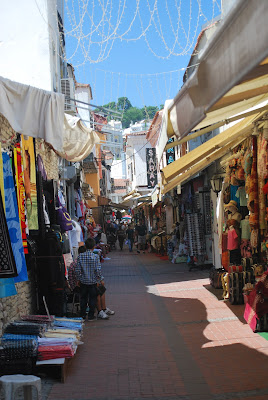We docked at our final port, Souda, on the island of Crete, early in the morning and having decided to spend a little less than before, Em opted to use her manual chair so that we could just take a taxi or bus to Chania, the real destination for the area. As it turned out, the fleet of local buses cycling through on the tarmac alongside the boat were just as equipped with ramps for electric power chairs as ones at home, and, as we later discovered, the streets of Chania had a few cut curbs (though again our trusty travel ramp was handy) and fairly level and smooth cobblestone sidewalks.
By 10am, it was already in the high 30's (around 90 Fahrenheit), so we walked in the shady sidestreets of Chania, leading down to the harbor...

Yiali Tzami mosque, built when the Turks conquered the island in 1649 (pesky Ottomans!), anchors the center of the harbor; after the Greek war for independence, nearly all the Muslims left Crete, and the mosque closed in 1923. It now houses art exhibits and provides a shady spot with a heck of a view...
Yiali Tzami mosque, built when the Turks conquered the island in 1649 (pesky Ottomans!), anchors the center of the harbor; after the Greek war for independence, nearly all the Muslims left Crete, and the mosque closed in 1923. It now houses art exhibits and provides a shady spot with a heck of a view...
 The lighthouse was built at the harbour entrance by the Venetians and restored in its present form by the Egyptians (1830-1840).
The lighthouse was built at the harbour entrance by the Venetians and restored in its present form by the Egyptians (1830-1840).
The Harbor was
built by the Venetians between 1320 and 1356. The harbour was used for
commerce and also to control the Sea of Crete against pirates.
The Venetian harbor had room for 40 galleys, but it
constantly silted up and was never very deep, so it kept having to be
dredged, a difficult job with the equipment of the time.
On its north side, the harbor is protected by a
breakwater. Near the middle of this is a small bulwark like a gun
emplacement and the tiny chapel of St Nicholas. This was where the
Venetians and Turks executed condemned prisoners.
The Firkas Fortress at the harbour entrance and the St
Nicholas bastion in the middle of the breakwater defended the harbour
from raiders.
A cruiseship (not ours) tendered, rather than docked; we never had to do so, but apparently they get folks out to port via little ferries, which you can make out towards the aft of the ship, heading in.
All the cafes on the Harbor Row are cute, fairly authentic, and offer the three things most needed by travelers in July: shade, fans and beer.
Sidenote: I ordered "the largest beer you've got", and they brought me this hearty boot with a liter of lager, below...

...and then I looked over at the next cafe, and saw a guy with a boot easily twice the size of mine! The excellent Greek sampler plate and tomato-and-feta salad kept me from changing cafes, I'll admit, but only just!Sidenote: I ordered "the largest beer you've got", and they brought me this hearty boot with a liter of lager, below...

Fish that eat your dead skin... and can evidently give you hepatitis, if the internet is to be believed...

Leather sandals and hats and luggage, phallic wooden bottle openers, bottles of sand and water... all the trinkets you imagine being in a Greek tourist area.
Greek: looks like all the buttons you never push on a calculator...
Tomorrow, a day at sea, steaming back to Rome! Then, onto England!
Tomorrow, a day at sea, steaming back to Rome! Then, onto England!





























































